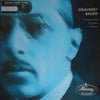



Stravinsky Ballets : The Firebird, Petrouchka, The Rite Of Spring – Antal Dorati, London Symphony Orchestra, Minneapolis Symphony Orchestra (3LP, Box set)
Rarity - Sealed
COMPILATION
Igor Stravinsky - The Firebird, Petrouchka, The Rite Of Spring
London Symphony Orchestra (A1 to B2), Minneapolis Symphony Orchestra (C1 to F1)
Conductor - Antal Dorati
3 LP, Box set, 12 page booklet
Original analog Master tape : YES
Heavy Press : 180g
Record color : black
Speed : 33 RPM
Size : 12'’
Stereo
Studio
Record Press : Pallas
Label : Speakers Corner
Original Label : Philips
Recorded June 7, 1959 at Watford Town Hall (A1 to B2)
Recorded at Northrop Memorial Auditorium on April 20, 1959 (C1 to D2) and November 15, 1959 (E1 to F1)
Engineered by C. Robert Fine
Produced by Wilma Cozart
Transferred by George Piros
Lacquer cut at Emil Berliner Studios by Maarten De Boer
The Firebird Painting by Marc Chagall
Originally released in 1980 (Compilation)
Reissued in 2010
Tracks :
Side A:
- The Firebird – Introduction And Scene I (Beginning)
Side B:
- The Firebird – Scene I (Concluded)
- The Firebird – Scene II
Side C:
- Petrouchka – Scene I: The Shrove-Tide Fair—Russian Dance
- Petrouchka – Scene II: In Petrouchka's Room
- Petrouchka – Scene III: In The Moor's Room
Side D:
- Petrouchka – Scene III: (Concluded) Dance Of The Ballerina And The Moor
- Petrouchka – Scene IV: The Shrove-Tide Fair—Wet-Nurses' Dance—Peasant With Bear—Dance Of The Gypsies And Rake Vendor—Coachmen's Dance—The Maskers. The Scuffle Between The Moor And Petrouchka. The Death Of Petrouchka.
Side E:
- The Rite Of Spring – Part I
Side F:
- The Rite Of Spring – Part II
Reviews:
“(…) I personally think that the first three ballets are inseparable and it makes much musical sense to listen through Firebird/Petrushka/Rite of Spring (in that sequence) as a cycle in one evening. And that's probably what this Speakers Corner box set out to do.
The original recordings were of course another legend in the recording industry. The legend maker in this instance was C. Robert Fine, chief engineer and technical supervisor of the Mercury Living Presence Series who pioneered the three-channel miking technique to fully capture orchestral bloom and natural resonance within the auditorium on half-inch tape or 35mm magnetic film.
I swore I never missed vinyl until I listened to this album. How wrong Id been. The Speakers Corner 180g vinyl is virtually free of surface noise. Sonic quality is superb, resolution on par with DSD and musicality second to none. Soundstaging easily challenges 3-channel SACD's width and depth. Instrumental localization is just as holographic. The loudspeakers virtually disappear. That was unheard of in my old LP days some thirty years ago. Bearing in mind I am only using two humble LP setups -- Denon DP-59L turntable with Denon DL-302 MC cartridge (KingRex PREference + NuForce Reference 9 V2 SE + Dynaudio Facette) and Rega Planar 3 with Rega Elys MM cartridge (Symphonic Line RG3 Mk3 + RG4 Mk3 + Apogee Centaur Minor) -- I'm sure you could get more impressive sonics with state-of-the-art analogue source equipment.
I've kept the best for last. One inseparable legend that has made this Stravinsky journey a lifetime experience is Hungarian conductor Antal Dorati (1906-1988). Being a composer himself (student of Bartók and Kodály) and one of the most recorded conductors with nearly 600 recordings many of which won international prizes, Dorati is mostly remembered as a symphonic conductor for the Dallas Symphony, Minneapolis Symphony, Royal Philharmonic and Detriot Symphony. But he had a deep-rooted affinity for ballet. His ballet era spanned from 1934 to 1941 when he was tenured with the two most influential ballet companies of the time. First he was appointed assistant conductor and then promoted musical director of Ballet Russe de Monte Carlo, the company succeeding Diaghilev's death. Second, he was musical director to the American Ballet Theater of New York, one of America's foremost ballet companies. Few conductors of his time had the same sensitivity to the performing arts. (A few exceptions were Ernest Ansermet, Diaghilev's conductor of the Ballet Russe, and of course Richard Bonynge and Antonio de Almeida.) Even the great Karajan at times was so obsessed with symphonic euphony that he displayed apathy for dancers with inappropriate tempi that were undanceable like his Decca recording of Delibes' Coppelia excerpts.
But Dorati did more than just getting the tempo right. His rhythmic pulse was in sync with the dancers' heart beats. His ability to carve out every emotional detail in Stravinsky's action music personified the dancers' facial expressions. The Firebird is perhaps the most remarkable of the three recordings in this album in the sense that Dorati conducted an orchestra not his own but rather, the London Symphony. Before The Firebird, Dorati had already conducted many concerts with the LSO and recorded, among others, Händel, Haydn and Mozart, Rimsky-Korsakov's The Golden Cockerel, Borodin's Polovtsian Dances, Prokofiev's Love for Three Oranges and Scynthian Suite and Respighi's The Birds and Brazilian Impression, all of them now the most admired recordings in the Mercury catalog. It should be noted that until then, British orchestras had hardly touched the complete ballet score of The Firebird and only a few had the experience with the various suites concocted by the composer.
It is therefore fair to say that Dorati painstakingly trained the LSO to master the complex strands of this highly challenging work. What made the Dorati/LSO collaboration such a matchless historical event of the century was the fact that the London Symphony at that time had assembled the finest musicians of the country as principals - Hugh Maguire (first violin), Neville Marriner (second), Simon Streatfield (viola), Kenneth Heath (cello), Stuart Knussen (double-bass), Alex Murray (flute), Roger Lord (oboe), Gervase de Peyer (clarinet), William Waterhouse (bassoon), Barry Tuckwell (horn), Alan Stringer (trumpet) and Denis Wick (trombone). Some of these fine musicians fondly remember Dorati as a formidable orchestra builder with charisma and a fiery temper.
The Firebird inherited the traditional Russian folkloric theatricality reminiscent of Rimsky-Korsakov's The Golden Cockerel and the fairy-tale romance of Tchaikovsky's Swan Lake yet it is imbued with a foretaste of Stravinsky's eccentric compositional techniques. Dorati handled the nuances with impeccable style. I couldn't help my eyes from chasing the instruments around through the dashingly delicate interactions between brass, woodwind and strings that signify the hide-and-seek game between prince Ivan and the thirteen princesses. The lovely round dance theme of the princesses on oboe with velvety strings contrasts with the erratic firebird theme in agile rhythms and whirling glissandi. When the demonic "Infernal Dance" fires up clashing rhythms and percussive attacks, the cascades of brass layers are so very barbaric and un-LSO. The diabolical tension is only temporarily relieved as the evil magician dreams of his hidden death denoted by the sinister chords from bassoon, tuba and lower strings creeping up from the far back of the stage.
Petrushka was Stravinsky's ultimatum to break away from the traditional orchestration of tonal blending and conventional composition technique of thematic development. Dorati faithfully executed it with suaveness and confidence. With the Minneapolis Symphony, Dorati was like a virtuoso on a fine musical instrument. He managed to exact the individual timbre and characteristics of each instrument or instrumental group, variegated colors, contrasts, brightness and transparency. In doing so, the collage-like melodies became one whole picture. Yet those are merely technicalities. The most impressive part of Dorati's interpretation is the pictorial description of the overall burlesque scenario and the psychological mood painting of the love triangle between the three puppet characters - as though Dorati conducted from the pit with his eyes and mind on the dancers at all times.
The Rite of Spring is the musical representation of the ungovernable power of nature. It is up to the conductor to represent it in a governable choreographic manner such that every movement in sound has purpose and direction. This was exactly what Dorati did. The dynamic strength of the polytonal lines is always properly channeled, maintaining a center of tonal gravity. The constant mezzoforte in the introduction is always driven by expressive bravado rather than excessive savagery. The polyrhythmic mesh is always clearly defined to ensure danceability despite the final "Sacrifice Dance" whose rhythm changes 154 times in the course of 275 bars. If your idea of The Rite of Spring is about explosive dissonance and chaotic rhythms, Dorati will put you right back on course. Pagan Russia was savage to the modern eyes but I'm sure it wasn't so in its time. What Dorati did was travel back in time, relive the old 'civilization' and present us with a 'civilized' Rite of Spring. After all, Stravinsky himself tried to tone down the intro's savagery (which was never intended) by dominating it with woodwinds rather than strings, fearing that "stringed instruments remind one too strongly of the human voice". I personally find Dorati's woodwind rendition here to be one of Stravinsky's most poetic moments.” Six Moons Review by David Kan
Ratings :
Discogs :


